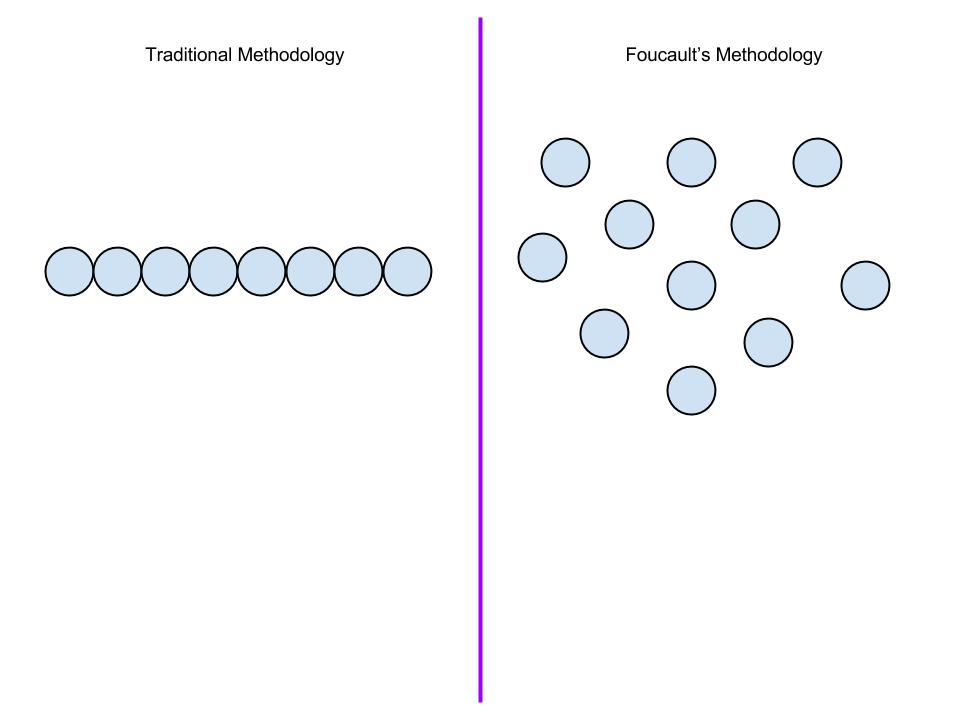The first two parts of Foucault’s Archaeology of Knowledge reminded me why I have always avoided literature and philosophy. Reading Foucault was like trying to run through mud. I spent much of my time flipping back and forth between different chapters, dictionaries, and Google in order to make heads or tails (or any other part) of Foucault. There were too many words that I could not define or pronounce. So, I have come to the conclusion that in about 15 years, I will read Foucault and it will make sense. For now, I will keep running through the mud and fake it till I make it.
Part 1: History and the Historian
Part 1 served as a reminder of how much Foucault I have managed to avoid. He refers to previous works several times, which required me to take several quick trips to Wikipedia. The two terms that stood out in the introduction were history and document. History is defined as “one way in which a society recognizes and develops a mass of documentation with with it is inextricably linked” (7). History transform documents into monuments. There is a change in what constitutes history. The most significant change is the document. The relation between history and the document has changed. History is no longer linear.
history has altered its position in relation to the document: it has taken as its primary task, not the interpretation of the document, nor the attempt to decide whether it is telling the truth or what it is it expressive value, but to work on it from within and to develop it; history now organizes the document, divides it up, distributes it, orders it, arranges it in levels, establishes series, distinguishes between what is relevant and what is not, discovers elements, defines, unities, and describes relations” (6-7).
This visualization helped me to understand the change or shift from progressive, linear history that has unity to the more expansive, complex history (dispersion).
Part 2: T.G.F.B (Thank God For Books)
I started Part 2 of Foucault in quite a funk. I was still trying to wrap my head around all the terminology from Part 1. I was also pushing my self to understand and make connections. My ray of hope came on page 23:
The frontiers of a book are never clear-cut: beyond the title, the first lines, and the last full stop, beyond its internal configuration and its autonomous form, it is caught up in a system of references to other books, other texts, other sentences: it is a node within a network.
This passage was my light-bulb-moment. My first thought was: yes, of course. Books/texts enter into conversation with one another all the time. That is what academic writing is all about. Then Foucault hit me with this next part:
And this network of references is not the same in the case of a mathematical treatise, a textual commentary, a historical account, and an episode in a novel cycle; the unity of the book, even in the sense of a group of relations, cannot be regarded as identical in each case. The book is not simply the object that one holds in one’s hands; and it cannot remain within the little parallelepiped that contains it; its unity is variable and relative. As soon as one questions that unity, it loses its self-evidence; it indicates itself, constructs itself, only on the basis of a complex field of discourse.
This section helped me to make connections to a concept that I already understand: intertextuality. With intertextuality, the reader brings knowledge and experiences of reading other texts to the reading of the new text. This section of Foucault’s work reminded me of discussions I’ve had in other classes about one book’s dialogue with another. This of course lead me to Kristeva and Bakhtin. Kristeva goes beyond the idea that texts are in conversation or a network of references, presenting that the text, itself, is made up of utterances taken from other texts. Kristeva’s work is influenced by Bakhtin’s definition of the novel as a combination of diverse languages and voices organized in an artistic manner.
The connection to books helped me to visualize and ground Foucualt’s work. Hopefully, I will have another light-bulb moment in Parts 3-5.
Key Terms
- Discontinuity-is a break with unity, challenges cause, effect, and tradition
- Discourse-this was a complex term in Foucualt’s work. I think he uses it to refer to the verbal/written parts of history
- discursive formation: I’m still debating and fleshing this out.
- archaeology: Foucault’s approach to examining discourse of the past in order to understand the present; what led to now?
Works Cited
Bakhtin, Mikhail. The Dialogic Imagination: Four Essays Austin: University of Texas Press, 1992. Print.
Foucault, Michel. Archaeology of Knowledge. New York: Vintage, 2010. Print.
Kristeva, Julia. Desire in Language: A Semiotic Approach to Literature and Art. Ed. Leon S. Roudiez. New York: Columbia University Press, 1980. Print.

January 29, 2014 at 3:59 pm
Chvonne – I looked at Pt 1 (Dr. Rodrigo will examine Pt 2). The visualization is yours, I take it. I like that you used something along these lines to better enable you to think about his discussion. I didn’t see much of a summary or discussion but I directly connect that to your struggles with M. Foucault. It was interesting to learn you are a Bahktin kinda’ girl, and I can appreciate that. One suggestion: It might be useful to you to include more of the resources you tapped to help you understand the reading here on your entry. (I’m thinking long-term usage for comps.)